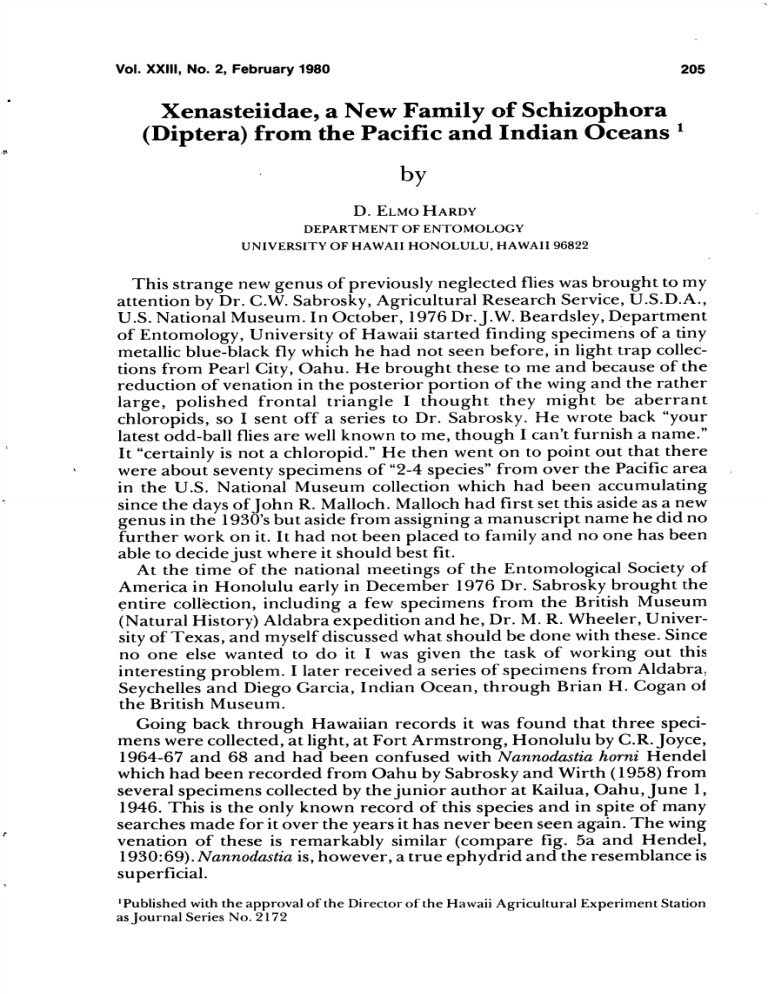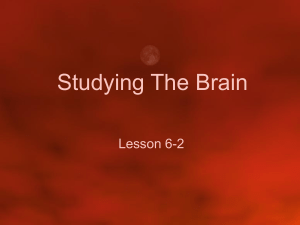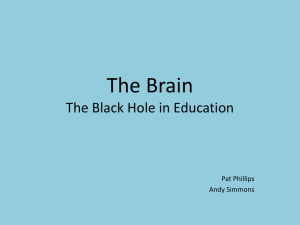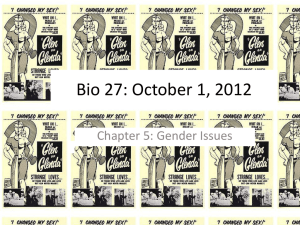(Diptera) from the Pacific and Indian Oceans *
advertisement

Vol. XXIII, No. 2, February 1980 205 Xenasteiidae, a New Family of Schizophora (Diptera) from the Pacific and Indian Oceans * by D. Elmo Hardy DEPARTMENT OF ENTOMOLOGY UNIVERSITY OF HAWAII HONOLULU, HAWAII 96822 This strange new genus of previously neglected flies was brought to my attention by Dr. C.W. Sabrosky, Agricultural Research Service, U.S.D.A., U.S. National Museum. In October, 1976 Dr. J.W. Beardsley, Department of Entomology, University of Hawaii started finding specimens of a tiny metallic blue-black fly which he had not seen before, in light trap collec tions from Pearl City, Oahu. He brought these to me and because of the reduction of venation in the posterior portion of the wing and the rather large, polished frontal triangle I thought they might be aberrant chloropids, so I sent off a series to Dr. Sabrosky. He wrote back "your latest odd-ball flies are well known to me, though I can't furnish a name." It "certainly is not a chloropid." He then went on to point out that there were about seventy specimens of "2-4 species" from over the Pacific area in the U.S. National Museum collection which had been accumulating since the days of John R. Malloch. Malloch had first set this aside as a new genus in the 1930's but aside from assigning a manuscript name he did no further work on it. It had not been placed to family and no one has been able to decide just where it should best fit. At the time of the national meetings of the Entomological Society of America in Honolulu early in December 1976 Dr. Sabrosky brought the entire collection, including a few specimens from the British Museum (Natural History) Aldabra expedition and he, Dr. M. R. Wheeler, Univer sity of Texas, and myself discussed what should be done with these. Since no one else wanted to do it I was given the task of working out this interesting problem. I later received a series of specimens from Aldabra. Seychelles and Diego Garcia, Indian Ocean, through Brian H. Cogan of the British Museum. Going back through Hawaiian records it was found that three speci mens were collected, at light, at Fort Armstrong, Honolulu by C.R.Joyce, 1964-67 and 68 and had been confused with Nannodastia horni Hendel which had been recorded from Oahu by Sabrosky and Wirth (1958) from several specimens collected by the junior author at Kailua, Oahu, June 1, 1946. This is the only known record of this species and in spite of many searches made for it over the years it has never been seen again. The wing venation of these is remarkably similar (compare fig. 5a and Hendel, 1930:69).Nannodastia is, however, a true ephydrid and the resemblance is superficial. •Published with the approval of the Director of the Hawaii Agricultural Experiment Station as Journal Series No. 2172 206 Proceedings, Hawaiian Entomological Society The type-genus isXenasteia n. genus. This is a cabinet name of Malloch's which was on a specimen in the U.S. National Museum, from Tahiti. It is very appropriate: Xenos, from the Greek, equals strange, combined with Aestia. The "gestalt" of the fly and the general characters of the head bristles, costal breaks, etc. used for differentiating families in most Diptera keys would seem to fit it nearest to the Milichiidae-Carnidae grouping of families. Following the most up to date phylogenetic classification (Grif fiths, 1972), however, it belongs in quite a different group of flies. The strange wing venation is unique from all other Diptera, with the exception of Nannodastia Hendel and Camus Nitzsch. The wings of these show remarkable parallelism, the venation is almost the same. The latter (fam ily Carnidae) has many features in common withXenasteia and is discussed below. Based upon abdominal characters, following Griffiths ,(1972:203) classification, this fits near Asteiidae by having spiracles only on segments 2-6 in both sexes; female terga and sterna represented by simple plates as far as segment 7 and the sclerites of segment 8 weakly expressed; two spermathecea; male with post abdomen asymmetrical, with sterna 6 and 7 developed on the left side and sternum 8 dorsal in position; also tergum 6 well developed, over half as long as 5. The antennae of Xenasteia are of the type characteristic of Asteiidae. This type is referred to by Hennig (1971:12) as "Hakenfuhler," with the third segment disk-shaped and directed sharply downward (fig. 5d). The second segment also has a prominent, curved, dorsoapical bristle and the first is reduced to a narrow ring as in the asteiids. The wing venation (fig. 5a) is asteiid-like in many ways, especially in the reduction of veins in the posterior portion of the wing: i.e. lacking m-cu crossvein, veins Cu or A and cell Cu. Sabrosky (1956:216) divided asteiids into two subfamilies as follows: Asteiinae—lacking m crossvein and alula, wing margin bare in alular area. Sigaloessinae—with m crossvein and alula and with an alular fringe of long hairs. Xenasteia fits intermediate between these by lacking m crossvein and with alula and alular fringe well developed. Sabrosky (loc. cit.) in his key to the genera of Asteiidae of the world keys three genera by having vein R2+3 long, ending in costa well beyond Ri; Xenasteia fits this characteristic. Hennig (1969:26) in his discussion of the groupings of the asteiids points out that two of these genera (Nothoasteia Malloch and Echidnocephalus Lamb) are almost certainly not asteiids and very probably belong in Anthomyzidae. Hennig retains Leiomyza Macquart in Asteiidae and adds the fossil genus Succinasteia Hendel, from baltic amber, which also has the comparatively long vein R2+3 (Hennig, loc. cit: 27, figs. 32 & 33). Both of these have the m crossvein present, also the alula and alular fringe are developed. A character which should be highly significant in allying Xenasteia with Leiomyza and Succinasteia is that the spiracular openings are on the edge of terga 2-6 (compare Hennig, 1958:638, fig. 292; 1969:29, fig. 39 and figures 5b and 5c). inAsteia Meigen, Bryania Aldrich and probably other typical asteiids the spiracles are in the membrane (Hennig, 1958:634, fig. Vol. XXIII, No. 2, February 1980 207 277) in both sexes. Xenasteia differs from Asteiidae in the following striking characters and I feel that these warrant giving new family status to this taxon. (1) Post ocellar bristles convergent. In asteiids they are parallel, diver gent, or absent. (2) Two pairs of superior fronto-orbitals and one pair of incurved, lower, inferior fronto-orbitals (fig. 7a). Asteiids have no inferior fronto- orbitals. (3) Sides of front not continuous as a sclerotized area down each side of face. In asteiids sides of front are continuous over sides of face, forming a sclerotized area on each side of peribuccal or subcranial area, bearing the prelabrum and proboscis, so as to form its lateral margins. This is sepa rated by a visible suture from the gena. This character is very prominent in Asteia; the ventral extensions are narrowed in Leiomyza, Bryonia and Leowimyia but are still present. (4) Inner postalar bristles present. Absent in Asteiidae. (5) Wings with two breaks in the costa (fig. 5a). Asteiids have the costa entire. (6) Propleural bristles present. I have not seen a propleural in asteiids which I have examined. (7) Second abdominal sternum of both sexes divided into two sclerites and first sternum represented by a narrow band (figs. 5b and 5c). This division may actually be of sternum one, the morphology is not clearly understood. In asteiids which I have examined the first sternum is quad rate, as long as wide and the second sternum is normal in shape, not divided. (8) Seventh tergum of male represented by a vestige on right side (fig. 5c). Absent in Asteiidae. (9) Aedeagus small, inconspicuous, not expanded distally, about 0.1 mm. long; the hypandrium with two pairs of well developed lobes, the anterior lobes with one or two strong spinules at apices (figs, la, 4a and 5e). In asteiids the aedeagus is rather slender, conspicuous, extended well beyond surstyli with the distiphallus sclerotized and enlarged and the lobes from the hypandrium are small, not with apical spines or setae. In the keys to the families of Diptera it will not fit any known family. In Brues, Melander and Carpenter, (1954) it runs imperfectly to Milichiidae in couplet 145 by having two costal breaks, subcosta incomplete, inflexed lower fronto-orbitals and postocellar bristles convergent. In Borror, DeLong and Triplehorn (1976:566) it also runs imperfectly to Milichiidae (couplet 124—also including Carnidae). Following Griffiths' classifica tion it fits in a different superfamily than Milichiidae. In Insects of Australia (Colless and McAlpine, 1970:717) it runs to couplet 29 by having incurved fronto-orbitals and subcosta incomplete. It runs imper fectly to Anthomyzidae (in part, some Stenomicra, etc.) by lacking the cubital cell. It differs from Stenomicra (=Aulacigastridae) by having the arista bare, the incomplete wing venation, etc. In Hennig (1973:16-17) it fits imperfectly in the first part of couplet 112 by lacking the cubital cell and m-cu crossvein. It differs from the rest of this couplet by having incurved lower fronto-orbitals. The families Ephydridae and Camillidae 208 Proceedings, Hawaiian Entomological Society key at this point but Xenasteia belongs in a different superfamily. In Griffiths' key (1972:265-274) it fits in his Superfamily Muscoidea by having the male postabdomen asymmetrical, with sixth and seventh sterna developed on the left side of the venter (fig. 5c) and the eighth sternum dorsal in position. It then fits his Prefamily Anthomyzoinea, couplet 51 by costa broken at end of Sc and runs near Trixoscelididae in couplet 69 by having postocellars convergent, ocellar bristles well de veloped, seventh abdominal spiracles lost in both sexes, but the aedeagal apodeme of the male, continuous with the hypandrium, not free. It is not closely related to the trixoscelidids, these are quite different flies, the relationship is much nearer to the Asteiidae. Trixocelididae are char acterized by having cell Cu (=A. of Hennig, et al.) and vein Cui + 1st A well developed; ocellar bristles placed laterally, outside ocellar swelling; no break in costa just beyond humeral vein; costal margin with prominent spinules; one or two pairs presutural dorsocentrals (except inParaneossus Wheeler); tibiae with preapical dorsal bristles; sixth tergum of male represented by a narrow band of dorsal sclerotization; seventh and eighth terga (male) absent; cerci (male) minute, fused; seventh sternum and tergum of female fused to form a complete ring (Hennig 1958:623, fig. 243) and female with three spermathecae. Griffiths' (1972:202) also says "the aedeagus is rod-like, without any sclerotized link with the hypan drium. The aedeagus bears a cylindrical phallophore, a pair of long paraphalli and in most species an expanded distal area with complex sclerotization (glans)." Dr. David McAlpine, The Australian Museum, Sydney, has examined specimens of Xenasteia and feels that it best fits in the family Carnidae and is related toAustralimyza Harrison which he places in Carnidae. He says (in litt.) that "the cephalic chaetotaxy is right for Carnidae, except that no typical carnid has to my knowledge, such strongly convergent postverticals—Antennae, mouthparts, prosternum, thoracic chaetotaxy are all about right. The wing venation is extraordinarily like that of Camus, though I rather think that Camus is derived from aNeoneura-like insect by reduction while your insect is perhaps derived from a different branch of the family. The lack of deep antennal fossae and mesopleural bristles, and presence of setulae on eyes are all more reminiscent of Australimyza. The two costal breaks agree with the north temperate genera as well as Australimyza but not Meoneurites and Neomeoneurites. The male postabdomen certainly resembles closely that of Australimyza and to some extent that ofHemeromyia in gross structures. The details of the hypan drium and internal structures I have not worked out, but there is ample evidence that these are the most plastic of structural characters above the species level. I would suggest that the Hawaiian fly is a new genus of Carnidae related to Australimyza but for one difficulty. The Carnidae (including Australimyza) have the female cerci fused and this insect ap pears to have them free." Dr. McAlpine sent specimens ofAustralimyza n. sp. for study and I have compared them with Xenasteia in careful detail. I would not agree that these belong in the same family, in fact I question whether or not they are even closely related. Griffiths (1972:163, 269) treats Australimyza as a new Vol. XXIII, No. 2, February 1980 209 family (Australimyzidae) under its own Prefamily (Australimyzoinea), differentiated from other Muscoidea which lack a longitudinal seam on the second antennal segment by having the tergum and sternum of the seventh abdominal segment of the male fused; the sixth tergum as large as the fifth and the epandrium (periandrium) divided into two halves lon gitudinally (the basimeres failing to meet across dorsum) in A. anistomae Harrison (not shown in the n. sp. at hand). Carnidae, as defined by Griffiths fits in the Prefamily Tephritoinea (Muscoidea) by having the male aedeagus elongate, flexible, coiled when at rest and bearing dense pubescence along the dorsal surface; epandrium not divided; 6th tergum male represented by a narrow band and the 7th and 8th abdominal segments of the female elongate, forming a slender rectractile ovipositor. In Australimyza the aedeagus is long and slender, with one coil, but is not hirsute dorsally and the terga and sterna of female segments 7 and 8 are heavily sclerotized, about one-half wider than long and are retracted into segment 6 when not extended. Xenasteia differs from Carnidae and Australimyza by having: (1). The postocellar bristles strongly convergent, not parallel. (2). Second antennal segment with a single rather strong, curved, dorsal bristle and bare on inner surface, rather than with two short, stout, dorsal setae and with setae on inner margin. (3). No antennal furrows on face. Carnidae typically have the antennae fitting into deep facial grooves, these are absent in Australimyza. (4). Only one sternopleural bristle not 2 or 3 and no humeral bristles. The latter are present in Carnidae. (5). Wings with m and m-cu crossveins, also cells M (basal) and Cu, and veins Cu and A lacking and with r-m crossvein basad in position, situated at or near forking of R 2+3 and R4+5. Typically Carnidae have a full complement of veins in the posterior portion of the wing, both cells M and Cu are present and the r-m crossvein is normal in position, well beyond forking of R 4. Camus is the exception, in this highly specialized ectopara site on birds the veins of the posterior portion of the wing are reduced, quite similar to Xenasteia but the r-m is not so basad and vein Cui + 1st A is represented as a fold. (6). Second sternum of both sexes divided into two sclerites (figs. 5b and 5c), rather than undivided. (7). Spiracles present only on abdominal segments 2-6 and located in the edges of the terga (figs. 5b and 5c). Carnidae typically have spiracles on the 7th segment and in all segments located in the membrane. In Hemeromyia Coquillett both 7th spiracles are absent, also I do not find these in Australimyza. In the latter I find the spiracles in the edges of the terga in the 9 and in the membrane in the d. (8). Female cerci free, not fused. (9). 7th tergum of male represented by a narrow rudiment on right side (fig. 5c). In Australimyza the 7th tergum is fused with the sternum and extends over the dorsum as a thin sclerite continuous onto the right side, or forming a complete ring (Griffiths, op. a7.:165). (10). 7th sternum of $ narrow, 5 or more times wider than long and 7th tergum represented by a narrow sclerotized band extending over dorsal 210 Proceedings, Hawaiian Entomological Society portion (fig. 5b); 8th sternum semimembranous, without a definite boundry and indistinctly bilobed apically. 8th tergum lacking, not differentiable; 7th and 8th segments scarcely telescoped into 6, not with a conspicuously rectractile ovipositor (ref. Hennig, 1965:186 and 1972:14-15). Australimyza with the terga and sterna of 7 and 8 sclerotized and about one-half wider than long. (11). Male aedeagus very short, not over 0.1 mm. in length including the apodeme. Consisting of a triangular projection surrounded by the two pairs of lobes arising from the hypandrium (figs, la, 3a, 4a). In Carnidae and Australimyza the aedeagus is elongate, coiled, etc., as noted above (ref. Griffiths, 1972:165 and 306, figs. 76 and 134). Dr. J.F. McAlpine, Biosystematics Research Institute, Ottawa, Canada, has kindly examined specimens and concluded that Xenasteia fits closest to Anthomyzidae because of the "hairy eyes, strong lower frontals, pinchedin face, strong subgenal bristle, form of antenna," the weakly developed humerus and presence of strong setulae on the margin of the alula. Also he says "one character I notice that also seems to be in agreement with Anthomyzidae is the tiny outstanding seta near the end of the costa in the tip of the wing. Most asteiids, anthomyzids and Teratomyza have this little bristle." McAlpine suggests that it should probably be placed as a peculiar member of this family, at least provisionally. The "pinched in face" char acter refers to the median portion of the face being strongly narrowed by the convex eye margins. In the species which I have on hand (Mumetopia Melander and Amygdalops Lamb) the face is scarcely over half as wide in median portion as on upper and lower margins. By comparison Xenasteia has the face only slightly narrowed medianly, the eye margins are gently convex on lower portions (fig. 7a) so the sides of the face are almost parallel. I question the phylogenetic importance of the presence of an outstand ing seta at end of the costa (one seta distinctly larger, ca. 1/3-1/2 longer than the other costal setae). This is present in Drosophilidae and Asteiidae. In the Anthomyzidae which I have on hand it is present in Amygdalops but is not differentiated in Mumetopia. The outstanding seta is present in Xenastda just before apex of vein R4 +5 (fig. 5a). The family concepts of Anthomyzidae have not been clearly defined and the limits of the family are uncertain. Hennig (1958:633) said it is one of the most difficult groups of the Schizophora to understand. The most definitive treatment of the family concept of Anthomyzidae is that of Griffiths (1972:198) (drawn in large part from Hennig, 1958 and "in press"). The features of this concept which would seem to negate the inclusion of Xenasteia in Anthomyzidae would be as follows: (1). Face (prefrons) with broad central membranous area (Colless and D.K. McAlpine, 1970:729, indicate that some genera—their concept— have the face entirely sclerotized). (2). Only one postalar bristle present. (3). Seventh abdominal spiracles present in both sexes and lying within the tergum. (4). Spiracles 2-6 situated in the membrane. (5). Aedeagus of male of very complex structure, well developed, con- Vol. XXIII, No. 2, February 1980 211 spicuous and expanded medianly. (6). Ejaculatory apodeme minute. In Xenasteia the face is entirely sclerotized; two postalars are present; seventh segment lacks spiracles and those of 2-6 are located in the edges of the terga (figs. 5b, 5c); aedeagus small, inconspicuous, simple in structure and apodeme well developed (figs. 3a, 4a); female ovipositor not extrusile, second abdominal sternum divided in both sexes (figs. 5b, 5c), etc. Because of the different placement of the abdominal spiracles, the divided first sternum, very different development of the male genitalia, radical departure in wing venation and "gestalt" I cannot see placing Xenasteia in Anthomyzidae. Xenasteia n. gen.—Summary of Generic Characters HEAD: Compound eyes almost round, covered with short erect setae. Head slightly expanded, convex on upper hind margin so that the upper portion of the occiput as seen in direct lateral view is almost obliterated, just a thin line remains; the occiput then gradually broadens to the gena where it is conspicuous, well developed. As seen from direct frontal view the head is nearly two times wider than long (fig. 7a). Head bristles as follows: one pair incurved lower fronto-orbitals; two pairs reclinate upper fronto-orbitals; postocellars convergent; ocellars strong, proclinate; two strong vertical bristles; vibrissae consisting of one strong, plus 6-8 smaller hairs; also two (in some species one or rarely three) proclinate setae on parafrontalia just inside line of upper fronto-orbital bristles and one reclinate orbital seta anterior to and in line with the lower fronto-orbitals (fig. 7a). Antennae as in figure 5d, with a prominent curved seta or small bristle on dorsum of second segment and the arista bare. Frontal triangle rather large, shining, covering all of median portion of the front and extending at least to a level with the incurved lower fronto-orbitals. THORAX: No numerals or post humerals; two notopleurals, the an terior notopleural is situated just behind humerus; one anterior supraalar; two postalars; one presutural; two postsutural dorsocentrals, with the posterior bristle strong and the anterior weak; 8-10 rows of acrostichal setae; four strong scutellars; no prescutellars; one strong sternopleural; one small propleural, located on lower margin just above front coxa. The humeri are rather poorly developed, scarcely discernable in most speci mens. WINGS: Densely microtrichose, with small spinules along costal margin. Costa with two breaks; subcosta incomplete; R2+3 ends beyond middle of distance between apex of Ri and R4 + 5 as figures 3c and 5a; crossvein r-m weak, situated near base of Rs; IVP + 2 weak, curved upward and evanescing about opposite tip of vein R2 + 3; vein M3+4 not reaching wing margin; veins Cu, A, m-cu crossvein and posterior and basal cells are lacking; alula well developed and with a fringe of long hairs (fig. 5a). ABDOMEN: Both sexes with the second sternum divided into two narrow plates, also the first sternum is represented by a narrow band. With spiracles only on segments 2-6 and the openings in the margins of the terga (figs. 5b and 5c). In the female with terga and sterna represented by simple plates as far as segment seven, with the eighth sternum weakly 212 Proceedings, Hawaiian Entomological Society sclerotized, represented by a pair of indistinct lobes and the eighth tergum scarcely differentiated, not sclerotized. The cerci are small but are separated, not fused. Two spermathecae (fig. 5g), these are heavily sclerotized, telescoped, very similar to many Scaptomyza (Drosophilidae). In the male the sixth tergum is developed on lateral margins, almost as wide as fifth tergum. The sixth and seventh sterna are situated on the left side and are devoid of setae except near the dorsal margins, the sixth is fused to the seventh on the upper edge and the seventh is fused with the eighth on its upper margin. Eighth sternum dorsal in position. Seventh tergum represented by a narrow vestige on the right side of abdomen and eighth tergum absent (fig. 5c). The genitalia are small, with surstyli and appendages (lobes) from the hypandrium well developed. The anterior pair of lobes from the hypandrium bearing two spines or strong setulae at apices (figs, la, 4a and 5e). The posterior lobes are usually long, slender pointed and fit above and to the sides of the aedeagus; these are referred to by Griffith (1972:36) as "the vertical sections of the hypandrial arms." The aedeagus is reduced in size, consisting of a prominent basal ring (phallophore) and a short, usually triangular shaped extension beyond. The aedeagal apodeme is rod-like and connects with the hypandrium. The entire aedeagus, including the apodeme measures slightly less than 0.1 mm. The cerci are large and conspicuous, setose (fig. 6a). Type of genus: Xenasteia sabroskyi n. gen. et sp. From the presently known distribution this taxon would appear to be restricted to islands and extends over a wide range of the Pacific and Indian Oceans. Specimens representing seven presently defined species are on hand from the following areas: Hawaiian Islands: Oahu Marshall Islands: Bikini Marianas: Guam, Saipan and Anatahan Society Islands: Tahiti Tuamotu Islands: Mangareva Western Caroline Islands—Palau Islands: Angaur, Peleliu and Koror; Yap. Ryukyu Islands: Okinawa Malaya: Pangkor Island, Perak. Indian Ocean: Aldabra, Mahe, Seychelles and Diego Garcia. This is obviously a very incomplete listing of the actual distribution of this genus. Due to its small size no attention has been given to it. Its biology and habits are totally unknown, the vast majority of the specimens col lected to date have been at light, a few specimens are labled "collected in grass or on low herbage" and one (from Diego Garcia) "collected on dead fish." I am grateful to Dr. C.W. Sabrosky for bringing this interesting taxon to my attention and for turning the specimens from the U.S. National Museum over to me for study. I am very appreciative of the most valuable assistance given me by Dr. G.C.D. Griffiths, Edmonton, Canada and the useful information and valued opinions provided by Dr. David McAlpine, The Australian Museum, Sydney and Dr. J.F. McAlpine, Biosystematics Research Institute, Ottawa, Canada. These outside opinions have been Vol. XXIII, No. 2, February 1980 213 most helpful in reaching a decision concerning the placement of this strange genus. I also thank Brian H. Cogan, British Museum (Natural History) for the loan of specimens from the Indian Ocean. The drawings were done by Mr. John W. Grubb, University of Hawaii. The excellence of this art work adds much to the importance of this study. Key to Presently Known Species of Xenasteia 1. Mesonotum concolorous, metallic blue-black or entirely polished ruf ous with a faint tinge of brown; at least upper half of pleura dark brown or colored like the mesonotum and front femora mostly brown except in ohinawaensis and palauensis Specimens not from the Indian Ocean 2 Anterior portion of mesonotum clear yellow to rufous, contrasting in color from the dark reddish brown to blue-black posterior portion; pleura yellow with only a slight tinge of brown on upper portion, except in seychellensis n. sp. which is characterized by having the surstyli of male exceptionally large and concave on inner surfaces (figs. 6a-c) Specimens from Indian Ocean 5 2. Basal two or more terga of abdomen conspicuously pale yellow-white; Vein R 2 + 3 elongate, third costal section nearly three times longer than fourth (fig. 3c); legs, palpi, halteres yellow; scutellum dark brown, not velvety Ryukyu Islands ohinawaensis, n. sp. Not fitting the above 3 3. Dorsum of thorax and abdomen metallic blue-black; knobs of halteres dark brown to black; all of pleura dark colored, reddish brown to blackish; femora mostly dark colored; anterior lobes from the hypandrium with comparatively short apical spinules (figs. 2a and 5e). 4 Thorax and abdomen rufous, with a faint metallic blue sheen; palpi, halteres, lower pleura and legs yellow, except for a tinge of brown on posterodorsal margin of front femur; anterior lobes from hypan drium with long spinules at apices (fig. 4a) Palau Islands palauensis, n. sp. 4. Surstyli slender, much thinner than anterior lobes from the hypan drium; posterior lobes from hypandrium rather short, triangular, not approximated in middle of genitalia (fig. 2a) Marianas and Western Caroline Islands divergens, n. sp. Surstyli thick, blunt apically, much thicker than lobes from hypan drium, approximately straight sided, not divergent; posterior lobes of hypandrium slender, long pointed and fitting parallel sided in median portion of genitalia (fig. 5e) Hawaiian Islands sabroskyi, n. sp. 214 Proceedings, Hawaiian Entomological Society 5. Anterior 2/3 of mesonotum pale colored, posterior portion dark red dish brown; basal 3-4 terga of abdomen mostly yellow; pleura yellow with only a tinge of brown on upper portion; surstyli of male about equal in width to, or slightly thicker than, anterior lobes of the hypandrium (figs, la and 7b) 6 Mesonotum mostly blue-black, rufous on anterior portion, at level of the humeri; abdomen all blue-black or rarely yellowich only on 1st tergum; upper half of pleura dark reddish brown; surstyli greatly expanded, concave on inner surfaces and many times thicker than lobes of hypandrium (figs. 6a-c) Seychelles seychellensis, n. sp. 6. Surstyli short and thick, rather straight sided, broadly blunt at apices, thicker than the slender anterior lobes from the hypandrium; the latter with only one small apical spinule plus a minute secondary spicule (fig. la) Aldabra aldabrae, n. sp. Surstyli slender, tapered, much thinner than anterior lobes from hypandrium; the latter rather thick and with two prominent apical spinules (fig. 7b) Diego Garcia similis, n. sp. la 1. Xenasteia aldabrae n. sp. a, male genitalia, ventral; b, male genitalia, lateral; c, female spermathecae. Xenasteia aldabrae n. sp. (figs, la-c) Very closely resembling similis n. sp., from Diego Garcia, the only differentiating characters that I see are in the male genitalia. X. aldabrae Vol. XXIII, No. 2, February 1980 215 has the surstyli short and thick, rather straight-sided, broadly blunt, nearly truncate at apices, thicker than the slender anterior lobes of the hypandrium. The latter with only one prominent apical spine plus a minute secondary spicule. Also the posterior lobes of the hypandrium differ in shape as in figures la-b and 7b-c. Male. HEAD: Mostly yellow except for the red compound eyes and with a faint tinge of brown in the ground color of the front, especially the upper portion, the occiput, and the dorsal portion of the third antennal segment. Bristling as typical of this genus and with two or three pairs of proclinate setae on upper portion of front just inside the upper frontoorbitals. THORAX: Largely yellow with sides and posterior portion of mesonotum tinged with brown, also upper portion of pleura faintly tinged with brown. Halteres yellow with a brown spot on outside median portion. Scutellum rather dark brown with a tinge of red in ground color. Metanotum mostly yellow with a narrow band of brown across upper margin. LEGS: Entirely yellow. WINGS: similar to those of other mem bers of the genus with the third costal section slightly over half longer than fourth, the measurements would be 7.0 : 4.2. Halteres yellow with a brown spot on the outside surface. ABDOMEN: Mostly metallic black with a faint tinge of red in ground color; basal two terga and median portions of three and four red, tinged with brown . Genitalia yellow, the char acteristics are as described above and as in figures la-b. Length: body 1.5 mm; wings 1.7mm. Female. Fitting description of male except for genital characters. Sper- mathecae as in figure lc. Length: body and wings about I.b5mm. Holotype male and allotype female, Aldabra: West Island, nr. settle ment. 21-31, Hi, 1968 (B. Cogan and A. Hutson). Sixteen paratypes, 11 males, 5 females collected by the Royal Society Expedition to the Aldabra atoll 1967-68, same data as type and South Island, Takamaka Pool. 1-17 ii, 1968 (B. Cogan and A. Hutson). All specimens were collected at light. Type, allotype and a series of paratypes returned to the British Museum (Natural History), other paratypes in the collections of the B.P. Bishop Museum, U.S. National Museum and the University of Hawaii. Proceedings, Hawaiian Entomological Society 216 2. Xenasteia divergens n. sp. a, male genitalia, ventral; b, male genitalia, lateral. Xenasteia divergens n. sp. (figs. 2a-b) By having the body concolorous metallic blue-black, tinged faintly with red in the ground color and the halteres and all of the pleura dark colored, brown to black; front femora typically dark brown and other femora tinged with brown it is like sabroskyi from Oahu, Hawaii. Except for having the palpi dark colored, brown to blackish and for genital characters I see no way to differentiate these species. X. divergens is differentiated from sabroskyi by having the surstyli slender, much thinner than the anterior lobes from the hypandrium and rather strongly curved outward, divergent. Also the posterior lobes of the hypandrium are short, rather triangular in shape and not approximated down the middle of the genitalia. Fitting the description ofsabroskyi in all details except for the dark palpi and the genital characters. The genitalia are as noted above and as shown in figures 2a-b. Length: body 1.3 mm.; wings 1.5 mm. Holotype male and allotype female, Pt. Ritidian,.Guam, Marianas Is lands, August 1, 1945 (J.L. Gressett) collected in light trap. Twenty-four paratype specimens from the Marianas (sexes mixed, these are all light trap specimens in rather poor condition, the dry heat has curled the abdomens under so they are very difficult to sex) from the following localities: same as type; Guam, collected May-August, 1936, 1945 and 1946 (O.H. Swezey, J.L. Gressitt, G.E. Bohart and N.L.H. Krauss); Saipan, May, 1940 and September, 1944 (the first collected by Yasu. and Yoshi., the latter with no collector given); and Anatahan,August, 1951 (R.M. Bohart). Also fifteen paratype specimens from the western Caroline Islands fit all the characteristics of divergens, they are from Koror, Palau Islands May 31, 1953 taken at light (J. W. Beardsley) and Yap group of Islands July, 1950 (RJ. Goss). Type, (Bishop 11,205) allotype and a series of para types returned to the B.P. Bishop Museum. Other paratypes in the collection of the U.S. National Museum, British Museum (Natural History), Kyusyu University, Fukuoka, japan and Uni versity of Hawaii. 217 Vol. XXIII, No. 2, February 1980 3c S.Xenasteia okznawaensis n. sp. a, male genitalia, ventral; b, male genitalia, lateral; c, anterior portion of wing. Xenasteia okinawaensis n. sp. (figs. 3a-c) Fitting the general characteristics of the genus and in the grouping of species which has the mesonotum entirely metallic blue-black with only a slight tinge of red in ground color and the upper half of each pleuron dark brown. It is differentiated from other members of this genus by having terga one and two conspicuously pale yellow-white; vein R2+3 elongate, third costal section nearly three times longer than fourth (fig. 3c); legs, palpi, and halteres yellow and scutellum dark brown, not velvety. The male genitalia are very characteristic because of the slender surstyli and anterior lobes of the hypandrium, with both these pairs of lobes strongly bowed. Male. HEAD: As in other members of this genus. With two proclinate setae on each side of front just inside the line between the upper frontoorbitals. Interfrontal area mostly brown, tinged with rufous except for the area occupied by the dark brown to blackish ocellar triangle and the anterior area immediately above the antennae which is yellow. The ocellar triangle extends approximately to the lower fronto-orbital bristles. An tennae yellow with a faint tinge of brown on the dorsal aspect of third segment. Face and mouthparts yellow except for a narrow rim bordering the oral margin. THORAX: Mesonotum dark brown with a blue-black sheen and a faint coloring of red in ground color. Scutellum dark brown, subshining and not velvety. Pleura pale yellow-white except for a dark band of brown extending across upper portions over mesopleuron, upper pteropleuron and metapleuron. Halteres pale yellow-white except for a small spot of brown on outside surface. Metanotum brown, tinged Proceedings, Hawaiian Entomological Society 218 with yellow. Humeri brown, tinged with yellow, the anterior margin yellow. LEGS: Entirely yellow. ABDOMEN: Basal two terga and entire median portion of third pale yellow-white, remainder of terga metallic blue-black, tinged with red over median portion. Genitalia are as in figure 3a. The surstyli are slender, curved inwardly and the apical half is covered with sensory pits (microspicules). The anterior lobes from the hypandrium are slender, curved inwardly, with the two apical spines situated close together and the posterior lobes are abruptly tapered at apices into slender points which parallel one another down the median line. The hypandrium is narrowed posteriorly as in figure 3a. Length: body 1.65 mm.; wings 2.0 mm. Female fitting the description of the male except for sexual characters. Holotype male, Sonabi, Okinawa, March, 1926 (C. Nibley). Allotype female Okinawa, November 5-18, 1961 (W.F. Pippin). Four male paratypes from the following localities on Okinawa: two same as allotype; one Camp Kae, in light trap, March 1962 (W.F. Pippin) and one Kinser, March 12, 1926 (C. Nibley). Type, allotype and two paratypes returned to the U.S. National Museum. Two paratypes in University of Hawaii collection. (Eventually to be placed in the B.P. Bishop Museum). 4b 4. Xenasteia palauensis n. sp. a, male genitalia, ventral; b, male genitalia, lateral. Xenasteia palauensis n. sp. (figs. 4a-b) This species is characterized by having the dorsum of thorax and abdomen entirely reddish with a faint tinge of metallic blue-black as seen in strong light, in combination with the very long spines at the apices of Vol. XXIII, No. 2, February 1980 219 the anterior pair of lobes arising from the hypandrium, the comparatively short and thick posterior lobes from the hypandrium and by the much better developed, more conspicuous aedeagus of the male (fig. 4a). Male. HEAD: Mostly yellow to rufous except for the compound eyes and including the appendages, with a tinge of brown to black along the top edge of the vertex and on the median hind portion of occiput. Ocellar triangle barely discernable and extending to about opposite the inclined lower fronto-orbitals. Only one pair of proclinate setae on parafrontalia, these are situated inside and just slightly above a level with the second pair of upper inferior fronto-orbitals. Bristles yellow. THORAX: Mostly red containing a faint tinge of brown, yellow onri, extreme lateral mar ns of mesonotum and over lower half of each pleuron. The acrostichal setae seem unusually long and conspicuous, the average seta is approx imately two-thirds the length of the anterior dorsocentrals. Halteres yellow-white with a smudge of brown on outside surface. Bristles and setae all yellow. LEGS: Entirely yellow except for brownish discoloration over the dorsal portion of the front femur. WINGS: Similar to those of other members of the genus with the third costal section approximately one-half longer than fourth. ABDOMEN: Entirely rufous with a very faint tinge of brown and a definite metallic blue-black sheen, as seen in strong light. The setae entirely yellow and rather conspicuous. The male genitalia appear to be distinctive. The surstyli are comparatively short and thick, the anterior lobes from the hypandrium are slender and curved and with two very prominent spines at apices. The posterior lobes from the hypandrium are comparatively short and thick and the aedeagus much more prominent than has been observed in other species (fig. 4a). Length: body and wings 1.3 mm. Female. Fitting the description of male except for genital differences. Also seeming to have more brown in the red coloration of the thorax and abdomen. In one paratype witabdomen having a mor distinctly blue-black sheen, especially on sides, than observed in other specimens. Holotype male and allotype female, Angaur I., Palau Islands, February 4, 1948, collected on dead leaves of Pandanus, Pacific Sci. Board, Ent. Surv. of Micronesia (H.F. Dybas). Six paratypes, five males and one female, from the following localities in the Palau Islands: Same as type; Peleiu I., N. Coast, January 24, 1948, collected beating vegetation (H.F. Dybas) and Peleliu, Amiangal Mt. December 22, 1952 at light (J.L. Gressitt). Type, allotype and two paratypes in U.S. National Museum, iwo paratypes deposited in the B.P. Bishop Museum and two in the University of Hawaii collection. An apparently new species is on hand from Bikini Is. Bikatoll, Marshall Islands, August-September, 1955 (M.R. Wheeler) which is very near palauensis. The only differentiating characters I see are in the genitalia. The posterior lobes of the hypandrium are much shorter and the anterior lobes are different in shape. Only four specimens are on hand, three males and one female and it is not being described until further materials can be studied. One female each which would also fit the description of palauensis are 220 Proceedings, Hawaiian Entomological Society on hand from Perak, Pulau Pangkor, Malaya, April 1, 1959, at light (R. Traub) and Taravi I. Mangareva Islands, sweeping grass and low herbage June 1, 1934 (E.C. Zimmeran). A male and a female from Arihiri Pare, Tahiti, Society Islands, March 15, 1934 (E.C. Zimmerman) also fits the color characteristic oipalauensis. These species with a general reddish coloration of the body obviously from a complex from over the Pacific area. b.Xenasteiasabroskyi n. sp. a, wing; b, female abdomen, ventral; c, male abdomen, ventral; d, antenna; e, male hypandrium, ventral; f, male hypandrium, lateral; g, female spermathecae. Vol. XXIII, No. 2, February 1980 221 Xenasteia sabroskyi n. sp. (figs. 5a-g) From external and superficial characters resembling divergens, which ranges over much of Micronesia. Differentiated by the male genital char acters as shown in figs. 2a-b and 5e-f; the surstyli thick, blunt apically, much thicker than the anterior lobes from the hypandrium and approx imately straight sided, not divergent and the posterior lobes from the hypandrium slender, long pointed at apices fitting parallel sided down the median portion of the genitalia (fig. 5e). Male. Predominently metallic blue-black with a faint reddish tinge in ground color. HEAD: Front mostly dark colored, reddish brown to black ish with a metallic sheen especially across the vertex and with the ocellar triangle extending almost to the lunule. Only one proclinate seta on the parafrontalia, inside and slightly above the lower pair of reclinate fronto-orbitals. Face yellow to rufous, faintly tinged with brown and with the epistomal margin dark brown, this is continuous as a narrow band on each side of oral margin. Palpi yellow with a faint tinge of brown along dorsal margins. Mouthparts yellow. Antenna as in figure 5d. THORAX: Typically dark metallic blue-black with a faint tinge of red in ground color. Pleura almost entirely dark colored, reddish brown to blackish. Scutellum velvety, dark brown to black. Halteres with the knobs entirely dark brown to black. LEGS: Mostly yellow with the front femora largely brown and with other femora tinged brown. WINGS: As in other mem bers of this genus but with vein R2+3 comparatively short, extending only a slight distance beyond the middle of the distance between the apices of veins Ri and R4+5 (fig. 5a). ABDOMEN: Entirely metallic blue-black. Genitalia very inconspicuous, brownish in color. The surstyli are rather thick, straight sided, blunt at apices, approximately two times wider than the anterior lobes from the hypandrium (fig. 5c). The anterior lobes of the hypandrium are straight sided with two short spines at apices and the posterior lobes are rather elongated, slender at apices and approximate one another down the midline of the genitalia. The aedeagus is repre sented by a pair of flap-like triangular structures extending from the hypandrium. Ventral aspects of the male abdomen as in figure 5c. Length: body 1.3-4 mm.; wings 1.5 mm. Female. Fitting description of male except for genital characters. The ventral aspect of the abdomen as in figure 5b. The spermathecae are as in figure 5g. It is a pleasure to name this species after Dr. C.W. Sabrosky, Agricul tural Research Service, U.S.D.A., U.S. National Museum who brought this interesting taxon to my attention. He also made it possible for me to study the collection of these flies in the U.S. National Museum collection and has been very helpful in working out the puzzle of the proper placement of this genus. The homeland of the population occurring on the island of Oahu is a complete mystery. When I first began investigating this genus it was assumed that this was the same as the species common throughout Mic ronesia but the two are completely different and no specimens have yet been found outside Hawaii which fit sabroskyi. It is most probable, how- 222 Proceedings, Hawaiian Entomological Society ever, that this is an immigrant species. The earliest known record is 1964 but it could have been overlooked for many decades before that time. It is apparently restricted to coastal areas or near coastal areas in the south western portion of the island of Oahu. Holotype male, Honolulu (Fort Armstrong), Hawaii, November 4, 1968, in light trap (C.R.Joyce). Allotype female, same data, October 19, 1964 (the earliest collection record). Also approximately 100 paratypes, sexes about even, from the following localities in the southwest coastal area of Oahu, all collected in light traps, October-December, 1976 (J.W. Beardsley and D.E. Hardy): Pearl City, near sewage treatment plant, Barbers Point and Ewa. Type (Bishop 11,206), allotype and a series of paratypes in the B.P. Bishop Museum. Paratypes are being deposited in the U.S. National Museum, British Museum (Natural History) and the University of Hawaii. 6. Xenasteia seychellensis n. sp. a, male genitalia, dorsal; b, male genitalia, ventral; c, male genitalia, lateral. Xenasteia seychelleesis n. sp. (figs. 6a-c) This species is differentiated from all others of this genus which have been seen to date by the very broad, expanded surstyli of the males. These are many times thicker than the lobes of the hypandrium and are concave on their inner surfaces (fig. 6c). By having the anterior portion of the mesonotum yellow to rufous it would fit in the same portion of the key as Vol. XXIII, No. 2, February 1980 223 the other two known species from the Indian ocean, but the pale colora tion of the mesonotum is confined mostly to the area opposite the humeri and the major portion of the mesonotum is shining blue-black; also the abdomen is entirely blue-black, the upper portions of the pleura are dark reddish brown, and the halteres are almost entirely dark brown over the knobs. Male. HEAD: Eyes sparsely short setose. Front brownish red except for the yellow extreme lower margin; the shining frontal triangle extends to a level slightly below the lower fronto-orbitals. Two pairs of proclinate setae situated on the orbits inside and between the upper reclinate bristles. Face yellow with a light tinge of brown. Clypeus pale brown. Antennae yellow with a tinge of brown on third segment and palpi entirely yellow. THORAX: Mostly blue-black over mesonotum with the anterior portion rufous in the area between the humeri and for a short distance down anteromedian portion. Scutellum dark brown to black with grey pubes cence, not velvety. Lower half of pleura yellow, upper portion reddish brown. Halteres with the knobs largely to entirely brown. WINGS: Similar to other members of this genus, with the third costal section (between tips of veins Ri and R22+3) two times longer than fourth (between vein R2+3 and R4 + 5;. LEGS: Entirely yellow. ABDOMEN: Entirely blue-black. Genitalia with the surstyli greatly expanded, concave on inner surfaces and much thicker than the lobes of the hypandrium (fig. 6c). The anteriro lobes from the hypandrium are very slender, convergent and with two short spines at apices. The posterior lobes extend parallel down the middle line above the aedeagus (fig. 6a). The aedeagus is small and inconspicuous (fig. 6b). Length: body 1.25 mm. Female. Fitting the description of the male except for genital characters. One paratype specimen has the first abdominal tergum yellow, tinged lightly with brown. In the allotype and other paratypes the abdomen is entirely blue-black. Length: body 1.5-1.7 mm. Type male, allotype female and three female paratypes from Mahe: Beau Vallon, Seychelles Islands, February 20-March 24, 1965 (Tarns and Nye). Type, allotype and one paratype returned to the British Museum (Natural History). Two paratypes in the collection of University of Hawaii. Proceedings, Hawaiian Entomological Society 224 7a 7'. Xenasteia similis n. sp. a, head, frontal view; b, male genitalia, ventral; c, male genitalia, lateral. Xenasteia similis n. sp. (figs. 7a-c) Closely resembling aldabrae but differentiated by the genital characters of the male. It is differentiated by the slender curved surstyli, two promi nent apical spines on anterior lobes of the hypandrium and by the sharply pointed posterior lobes from the hypandrium (compare figs, la-b and 7b-c). The genitalia are very similar to those of okinawaensis n. sp. (figs. 3a-b) and these species are obviously closely related. It is differentiated from okinawaensis by having the anterior two-thirds of the mesonotum yellow to rufous and the pleura yellow with only a slight tinge of brown on the upper portions, the basal terga of the abdomen are yellow to rufous, not pale yellow-white; also the third costal section is one-half longer than fourth, rather than nearly two times longer. Male. Fitting the description of aldabrae in most respects but with the front clear yellow on the lower two-thirds, sharply contrasting from the dark brown ocellar triangle; head as in figure 7a; third antennal segment entirely yellow; anterior two-thirds of mesonotum more distinctly yellow but with a faint tinge of brown in ground color. The scutellum is rufous, tinged with brown. The first two abdominal terga are clear rufous with a tinge of brown on the extreme lateral margins; terga three and four are broadly rufous on median portion, brown to blackish on sides and fifth tergum mostly dark reddish brown with a blackish sheen, rufous in Vol. XXIII, No. 2, February 1980 225 median portion for about three-fourths the length of the tergum. In some paratype specimens the fifth tergum is entirely dark colored with a metallic black sheen. Sixth tergum entirely dark brown. Wings similar to those of aldabrae with the third costal section about one-half longer than the fourth, 7.0:4.4. Male surstyli slender, rather strongly bowed inward. Hypandrium rather elongate, attenuated posteriorly. Anterior lobes of hypandrium with two prominent apical spines and the posterior lobes sharply attenuated into narrow points at apices, closely approximated down median portion (fig. 7b). Length, body 1.4 mm.; wings 1.6 mm. Female. Fitting the description of male except for genital characters. Holotype male, Chagos Arch.: Diego Garcia, Elipse Point, IV, 1971 (A.M. Hutson). Allotype female, same island, Roche Point, 1, V, 1971 (A.M. Hutson). Nineteen paratypes, 12 males, 7 females all from Diego Garcia by the same collector and collected from April 20-May 14, 1971 and from the following localities: DeMoulin; Simpson's Point; Balisage and Barachors See. Most specimens were collected at light; some were collected in open coconut grove; one specimen is labeled "Collected on dead fish." Type, allotype, a series of paratypes returned to British Museum (Natural History). Other paratypes deposited in the collections of U.S. National Museum, B.P. Bishop Museum and the University of Hawaii. References Cited Borror, DJ. , D.M. DeLong and C.A. Triplehorn, 1976 An Introduction to the study of Insects. 852 pp. Holt, Rinehart and Winston. Brues, C.T., A.L. Melander and R.M. Carpenter, 1954 Classification of Insects. 917 pp. Mus. Comparative Zoology, Cambridge, Mass. Griffiths, G.C.D. 1972 The phylogenetic classification of Diptera Cyclorrhapha. 340 pp. Dr. W. Junk N.V.— The Hague. Hendel, F. 1930 Eine neue interessante Ephydridengattung (Dipt.). Konowia 9:66-70 Hennig, W. 1958 Die Familien der Diptera Schizophora und ihre phylogenetischen Ver- wandtschaftsbeziehungen. Beitr. zur Entomologie 8(5/6):505-688. Hennig, W. 1965 Die Acalyptratae des Baltischen Bernsteins. Stutt. Beitr. zur Naturk. 145:1-145. Hennig, W. 1969 NeueUbersicht iiber die aus dem Baltischen Bernstein Bekannten Acalyptratae. Stutt. Beitr. zur Naturk. 209:1-42. Hennig, W. 1971. Neue Untersuchungen iiber dir Familien der Diptera Schizophora. Stutt. Beitr. zur Naturk, 226:1-76. Hennig, W. 1972 Beitrage zur kenntnis der rezenten und fossilen Carnidae, mit besonderer Be- riicksichtigung einer neuen Gattung aus Chile (Diptera: Cyclorrhapha). Stutt. Beitr. zur Naturk. 240:1-20. Sabrosky, C.W. and W.W. Wirth, 1958 A Formosan Ephydrid new to Hawaii (Diptera: Ephydridae). Not. Ent. 38:109-110. Sabrosky, C.W. 1956 Additions to the knowledge of old World Asteiidae (Diptera). Rev. franc. Ent. 23:216- 243.









